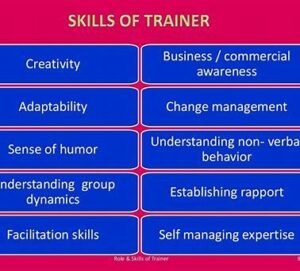Communication is where it all starts. When training, the power of your words can ignite curiosity or leave a room full of blank stares. Clear and concise communication is a vital skill for any business trainer. It’s about more than just getting a message across; it’s about ensuring that message sticks. Speaking in simple terms yet precisely hitting the mark helps trainees grasp complex concepts without feeling overwhelmed.

In the sea of communication tactics, active listening stands as a lighthouse. Engaging with your trainees isn’t just about showering them with facts. It’s crucial to tune into what they’re saying, whether through verbal cues or the nuanced language of the room. By posing thoughtful questions or nodding in understanding, you can create a dynamic dialogue that makes learning a shared venture.
click here to start your own online business for free Ced0224
Think communication is all about words? Think again! Body language and non-verbal cues speak volumes. A trainer who stands with open gestures and maintains eye contact exudes confidence and invites connection. Read the room—recognize when participants seem lost and adjust your delivery and interactions to draw them back in.
Adapting your communication style to meet diverse learner needs is a game changer. Not everyone learns the same way or speaks the same language metaphorically or literally. Adjusting your style to better fit the audience means experimenting with different approaches. Use visuals, storytelling, or even humor to cater to varying preferences and backgrounds.

By mastering these communication skills, business trainers not only enhance their sessions but also inspire their trainees to engage and interact with the material. This foundational skill set paves the way for deeper learning and participation from everyone involved.
Cultivating Emotional Intelligence: Navigating Human Dynamics
Navigating the emotional landscape of a training session requires more than just expertise in the subject matter. Emotional intelligence (EI) is your secret weapon. It’s like having a compass that guides you through the subtleties of human dynamics.
Recognizing your own emotions and understanding how they affect your training approach lays the groundwork for effective sessions. This self-awareness helps you maintain control in high-pressure environments and lets you guide the energy in the room positively.
Building empathy is another cornerstone in this emotional toolkit. By putting yourself in your trainees’ shoes, you not only connect better but also tailor your sessions to their comfort levels and learning styles. This rapport-building is essential for cultivating an engaging and supportive atmosphere.
Conflict management might not be what you signed up for, but it’s an inevitable part of any group setting. Developing strategies to address disagreements or misunderstandings with a cool head and a warm heart turning potential chaos into constructive communication.

A supportive and inclusive learning environment doesn’t happen by accident. It takes conscious effort to affirm everyone’s value and create a safe space for learning and expressing ideas. Encouraging participation and valuing diverse perspectives invites a richer dialogue and a more dynamic learning experience.
Mastering emotional intelligence elevates the role of a business trainer from an instructor to a facilitator of human potential. It’s all about bringing a personal touch that resonates on a deeper level, fostering not just knowledge, but also growth and development in every session.
Planning and Organization: Designing Impactful Training Sessions
Great training doesn’t happen without a plan. Crafting a structured yet flexible plan is your ticket to a successful session. It’s like sketching a roadmap where key objectives guide the way, but there’s room for scenic detours based on participants’ needs.
Organization is your best friend. Managing your time effectively during sessions can make or break the learning experience. By staying on schedule, you respect everyone’s time and set the tone for professionalism and efficiency, creating an environment where learning can flourish.

Let’s talk resources and technology. Using the right tools can elevate your training from good to unforgettable. Whether it’s a slick presentation or interactive software, the idea is to enhance understanding, not complicate it. Tailor your tech use to your audience’s comfort level and the session’s goals.
It’s essential to focus on feedback. A loop of constant improvement is what keeps training relevant and engaging. Gathering insights from trainees doesn’t just validate your approach, it also reveals areas for enhancement. Implement this feedback to refine your methods and ensure your sessions evolve with your audience’s expectations.
By planning meticulously and organizing effectively, trainers can deliver sessions that not only educate but also inspire participants to apply new knowledge with confidence. The seamless flow of a well-organized session makes complex ideas digestible and learning enjoyable.
Facilitating Learning: Strategies for Inspiring Knowledge Acquisition
Creating a learning environment that sparks curiosity and fosters engagement is a true art. It’s about designing sessions that invite active participation rather than passive reception.
Think interactive. The more hands-on activities you incorporate, the more you keep the room buzzing with excitement and interest. It’s about moving beyond lectures to create experiences where learners actively apply what they’re being taught.
One size doesn’t fit all when it comes to teaching methods. Incorporate a mix of approaches—like group work, discussions, and case studies—to cater to the different learning styles in the room. This diversity not only addresses the varied ways people learn but keeps the energy lively and dynamic.

Real-world examples are your best friend. They bridge the gap between theory and practice, showing trainees how concepts come to life in everyday scenarios. Use examples that resonate with your audience’s real-life challenges and goals.
Good questioning techniques are key. By posing thoughtful questions, you encourage a deeper level of thinking and involvement. Open-ended questions invite discussion, while probing questions challenge assumptions and deepen understanding.
When facilitation is focused on active involvement and real-life applications, you transform learning into an adventure where participants not only gain knowledge but are inspired to apply it with confidence and enthusiasm.
Staying Ahead: Continuous Professional Development as a Trainer
In a world where change is the only constant, staying ahead as a business trainer means never stopping your own learning. Professional development is not just a checkbox; it’s a mindset and a commitment to excellence.
The landscape of business training is rapidly evolving and requires trainers to be agile and open to new methods, technologies, and ideas. Embrace this change and incorporate fresh strategies and tools to keep your sessions relevant and engaging.
Keeping up with industry trends and advancements is crucial. Subscribe to industry publications, participate in webinars, and join professional associations. These resources can offer valuable insights and keep your content cutting-edge and impactful.

Networking is another powerful tool in a trainer’s arsenal. Engaging with peers at conferences and through online networks provides opportunities to exchange ideas and best practices. This interconnectedness fosters a vibrant community where trainers can learn from one another and grow together.
Self-reflection and feedback are crucial components of professional development. Regularly evaluate your own performance, seeking constructive criticism from peers and participants. This practice doesn’t just address areas for improvement but reinforces what you’re getting right.
By committing to lifelong learning and professional growth, business trainers can inspire confidence in their trainees and deliver transformative educational experiences that adapt to the ever-changing business landscape.
